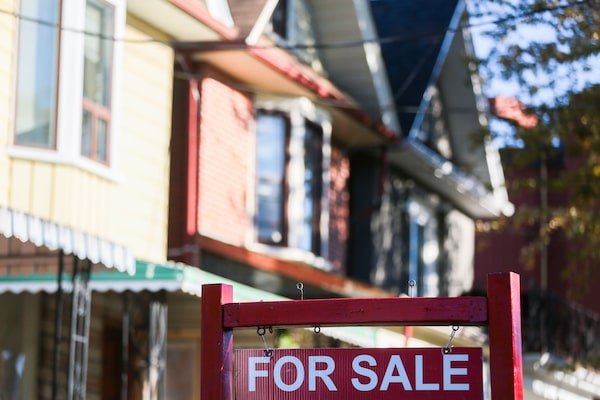
A real estate sign is displayed in front of a house in the Riverdale area of Toronto on September 29, 2021.Evan Buhler/The Canadian Press
The traditional spring upswing in the Toronto-area real estate market is behind schedule so far in 2023 as homeowners remain reluctant to list properties for sale.
“It is sluggish,” says John Pasalis, president of Realosophy Realty. “The market’s not behaving the way it normally does.”
In many years, homeowners like to place a sign on the lawn after the Ontario schools’ March break, when many families are vacationing.
Mr. Pasalis saw a slight increase in properties for sale as March break was winding down but not a significant bounce.
He notes that the odd pattern started early: New listings actually decreased in February compared with January – a result Mr. Pasalis calls “mind-blowing.”
Mr. Pasalis has been talking to real estate photographers and other service providers who have much less work than usual.
Meanwhile, the lack of inventory means sellers in urban neighbourhoods are receiving multiple offers, but the pace of each market varies by region, he says.
Mr. Pasalis crunched the numbers to see the change in the average sale price for low-rise houses in Toronto and surrounding areas in February from the peak one year earlier.
Mr. Pasalis included rowhouses, semi-detached and detached houses, but not condo townhouses or high-rises.
Toronto saw a decline of 15 per cent to $1,606,591 in February from a high-water mark of $1,889,178 in the same month last year.
Richmond Hill, north of the city, edged out that performance with a 14-per-cent dip in the same period to $1,644,146 from $1,914,379.
In Vaughan, the average low-rise price dropped 17 per cent to $1,643,499 from $1,970,730 in the same period.
Mr. Pasalis says these regions may have held up better than other harder-hit areas because they have seen a boost in population from immigration.
Some of the areas with more severe slides include Brock Township, Caledon, Pickering and Scugog.
The Township of Brock, set on the east shore of Lake Simcoe, is about 100 kilometres north-east of downtown Toronto. Communities there, including Beaverton, Cannington and Sunderland, became popular with buyers seeking more space during the pandemic.
The average price in the area tumbled 37 per cent to $713,042 in February for a low-rise home from a milestone of $1,124,119 in February, 2022.
In Caledon the average price fell 36 per cent to $1,200,252 from $1,864,257 in the same period.
Mr. Pasalis says many of the areas that saw steep declines are relatively rural and a fair distance from Toronto’s core.
“It’s probably very close to the opposite of how they accelerated.”
Durham Region, east of Toronto, has long been among the most affordable bedroom communities.
For first-time buyers of detached homes, it is one of the few areas where they can find a property under the $1-million mark, Mr. Pasalis says.
“If your budget is in the nines, you might get that in Durham,” he says.
In the city of Oshawa, for example, the average low-rise price was $816,742 last month to mark a 31-per-cent drop from the peak at $1,180,860 in February of last year.
In Toronto, properties in the Leslieville neighbourhood, where Mr. Pasalis does much of his business, often draw multiple offers, he says.
While there have been some very aggressive offers, he says, even when 15 or so buyers are vying for a property, the sale prices are usually not wildly unexpected.
Some asking prices are ridiculously low, he says, but buyers are often paying $200,000 or $300,000 over asking.
Many were lobbing much higher amounts over asking to win bidding wars last year.
“Buyers are really constrained financially,” he says, as they face higher interest rates.
Mr. Pasalis points to that constraint as one reason for the lack of listings.
First-time buyers may decide to move ahead with their plans because they need a house, but move-up buyers have the option of staying where they are.
The move to a larger and more expensive property is a luxury, he says, and the price tag has become a lot higher with climbing interest rates.
Since most people are buyers and sellers at the same time, those people who choose to stay put are keeping their existing property off the market and therefore inventory remains slim.
Another reason is that some downsizers who are considering a sale hope that prices will rebound to the highs of last year.
“There is an aversion to losses,” he says. “The loss is based on what they could have sold for at the absolute peak of the market. Definitely some people just have their eye on that.”
On a national level, Farah Omran, economist at Bank of Nova Scotia, notes that homes sales rose 2.3 per cent on a seasonally adjusted basis in February from January, despite a whopping 7.9-per-cent drop in listings in the same period.
Overall, Canada’s housing market remained in balanced territory, she says, noting a fairly even split between markets that saw sales increase and those where sales declined. The drop in listings was more widespread.
Vancouver, Victoria and St. John’s posted double-digit increases in sales, while Quebec City, Hamilton, Winnipeg and Guelph saw declines in February compared with January.
Ms. Omran cautions that a large amount of uncertainty surrounds the housing market, with bank failures, turbulence in financial markets and sticky U.S. inflation further muddying the outlook for the Canadian and global economies.
She still expects the Bank of Canada to keep its key interest rate at 4.5 per cent before gradually cutting rates through 2024. Scotiabank is also forecasting a mild recession this year and slowing inflation.
She warns, however, that significant risks to the outlook on rates remain.
Ms. Omran still sees room for house prices to drop in Canada, but she believes that the bulk of the decline has already taken place.
 Carolyn Ireland
Carolyn Ireland